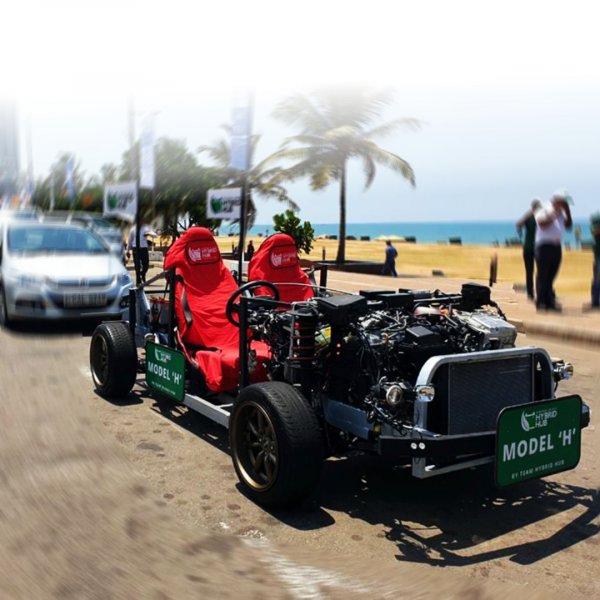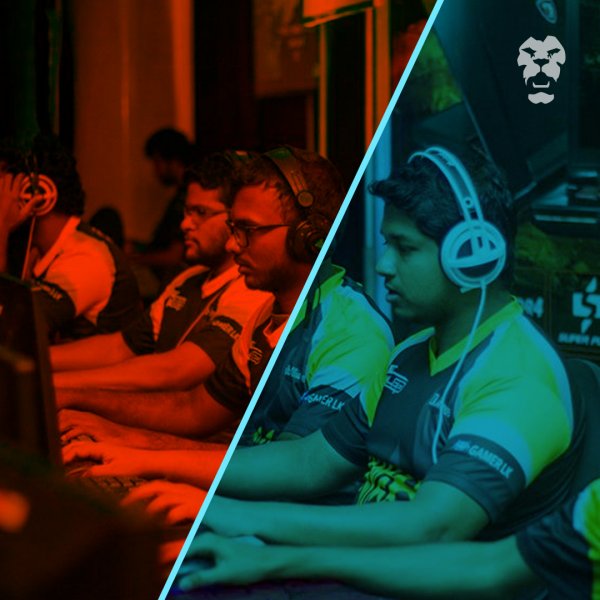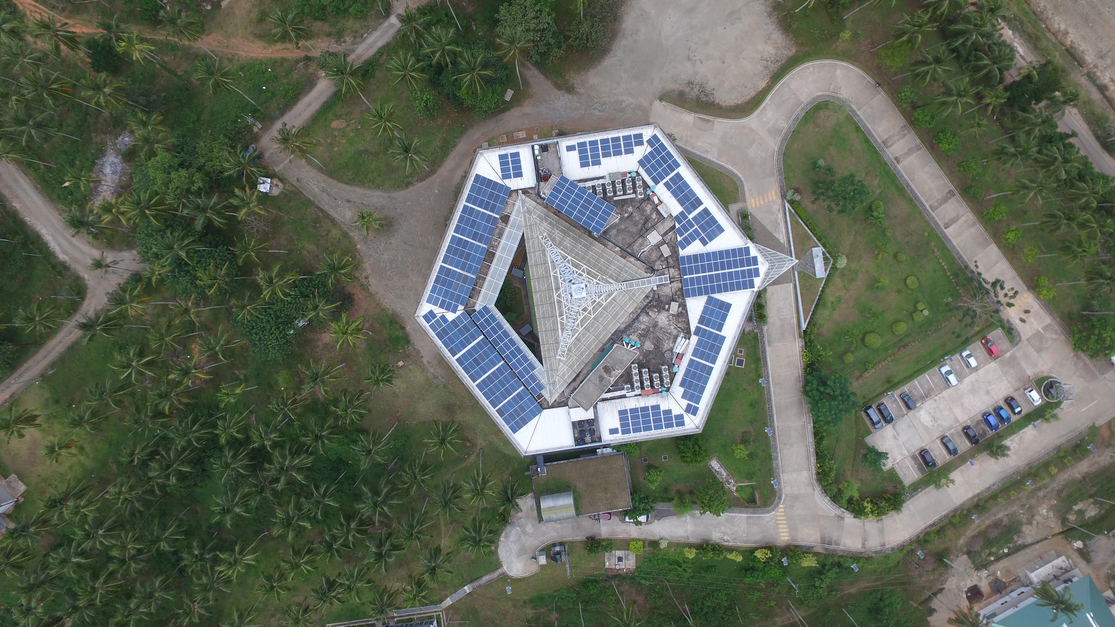
The tuk tuk rolls to a stop in front of a shiny steel gate, behind which is an imposing modern building that is somewhat out of place amongst the paddy fields and unassuming houses that dot the landscape of Pitipana, Homagama. As we wait for the security officer to open the gate for us, we glance across the surroundings. In the distance we spot the NSBM Green University. A few hundred metres from where we stand is a building which houses the SLT Data Centre. A gaggle of students clutching laptops pass us by. It was now clear that we were standing in the heart of what will, in a few years from now, shape up to be the Homagama Tech City.
As we enter through the gate and make our way to the lobby of the Sri Lanka Institute of Nanotechnology, or SLINTEC for short, we can’t help but feel that beyond the large glass doors at the entrance, lies something special. Very, very special.

As the doors swing open, we are greeted by Dr. Rangika De Silva, who overlooks SLINTEC’s Technology Transfer Operations . Still in his late 20s, Dr. De Silva is one of a handful of rare PhDs who have chosen to move back to Sri Lanka after completing their education abroad. Unable to keep a lid on our curiosity any longer, we started chatting with him while he showed us around.
What is SLINTEC?
“Founded in 2008, SLINTEC is an institution that was set up as a public-private partnership between the Government of Sri Lanka and a few local blue chips, such as Brandix, MAS, Dialog, Loadstar and Hayleys, and later, Lankem. LOLC also joined this consortium recently,” states Dr. De Silva. “Our mission at SLINTEC is two-fold. One is to build a world-class research and development centre specialising in nanotechnology and advanced material sciences, with the objective of making products more competitive using such technologies and also to add value to Sri Lanka’s mineral resources. Second, to build a nanotechnology and science park for research, development, and the commercialisation of innovations in Sri Lanka”.
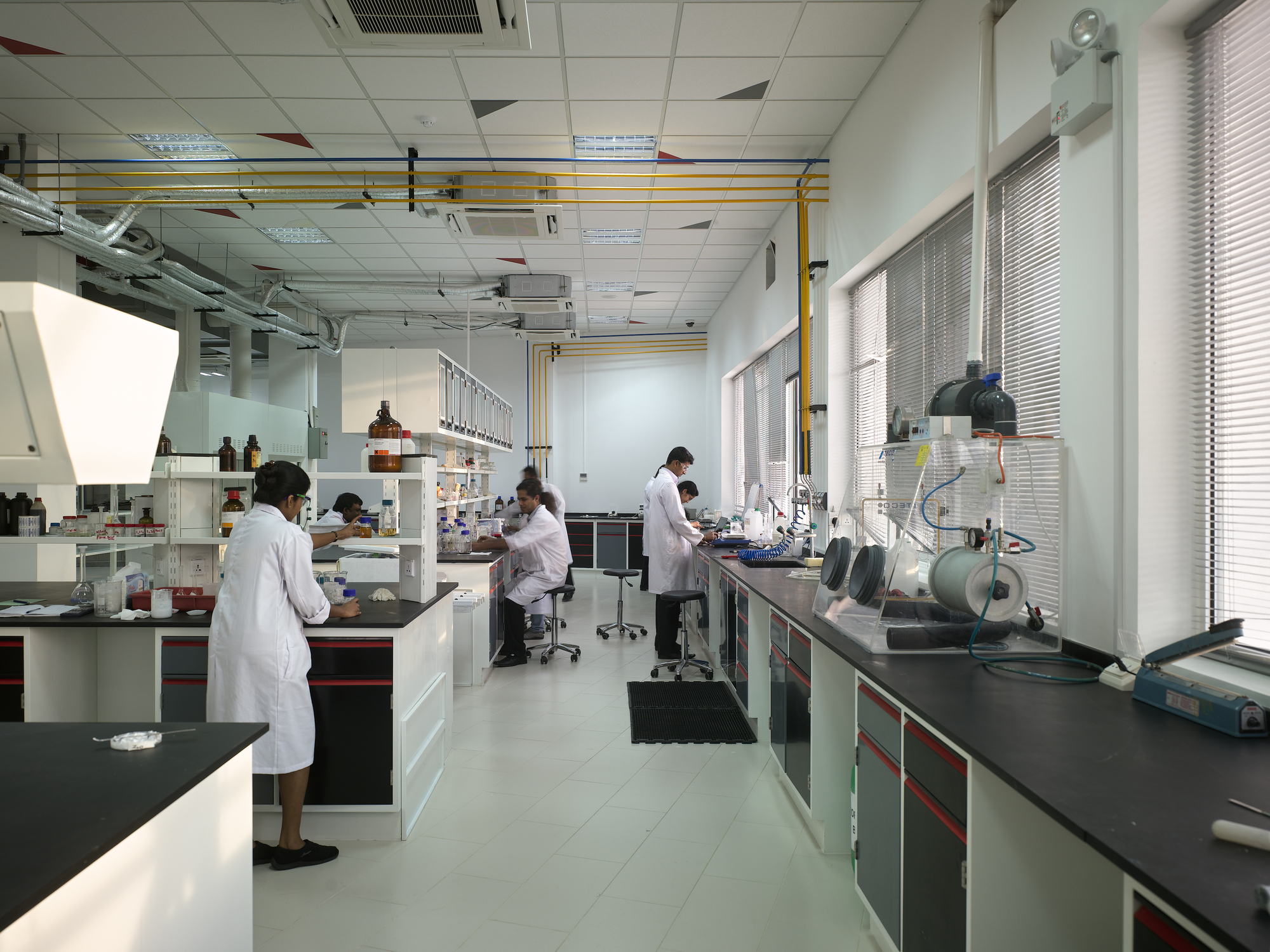
Though SLINTEC has just turned 10, it had to overcome its fair share of obstacles even before the first foundation stone was laid. A report published in the Sunday Times highlights how back in 2005, then Minister of Science and Technology Prof. Tissa Vitharana put forward a cabinet paper detailing how Sri Lanka can reap the benefits of the knowledge era by setting up a National Nanotechnology Initiative (NNI).
However, the government at the time did not wish to set up another fully state owned research institute, and thus requested private sector participation prior to pledging funding support. The committee formed to support the NNI managed to convince Brandix, Dialog, Hayleys, Loadstar, and MAS to invest in the project. By 2008, the cabinet paper was approved, and a public-private partnership structure was formulated for the project. The government agreed to fund 100% of the infrastructure and also pledged 50% of the funds required for operating capital through the National Science Foundation while the private sector partners chipped in for the remaining 50%, thus giving birth to SLINTEC.
By mid-2009, research work commenced in a newly built lab in the basement of an apparel factory in Biyagama. By 2013, the eye-catching hexagonal building we were now walking around in was completed, and the researchers of SLINTEC formally moved into their new home.
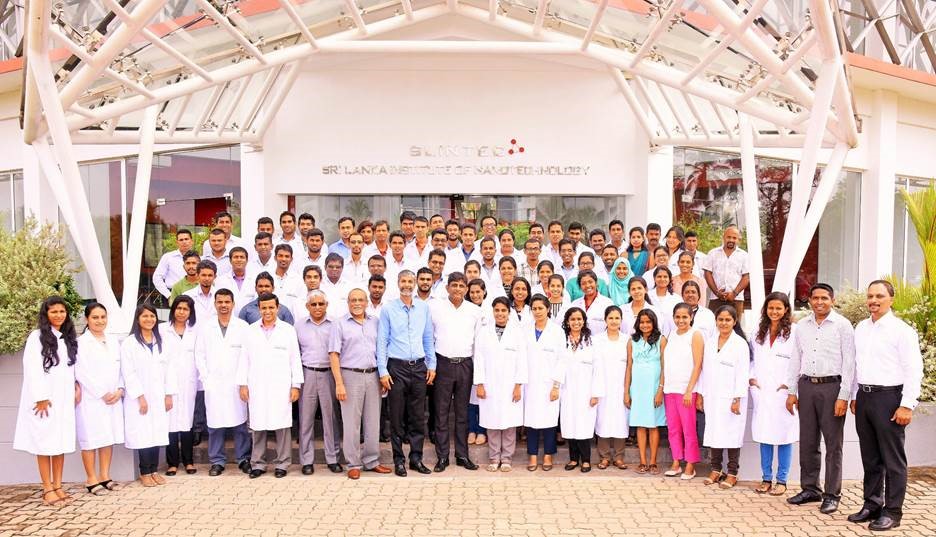
Why nanotechnology and advanced materials?
Being a small country with limited resources, Sri Lanka may find it hard to compete with the global giants of mass production. However, niche manufacturing is an area through which the country can enhance its export revenues. Another is knowledge-based exports, which leverage the intellectual capital of a country. In a way, SLINTEC is positioned at the intersection of these two spheres.
We arrive at the offices of Dr. Lakshitha Pahalagedara, the Head of Business Development of SLINTEC, and we pose the same question to him. “The reason why SLINTEC has chosen to focus on nanotechnology and advanced materials is because it is these technologies that can help greatly enhance the value addition to Sri Lanka’s exports. Take the case of graphite. Sri Lanka has one of the purest forms of graphite in the world. However, graphite in itself only fetches a very low price in the global market. But graphene, which is created by refining graphite, is more technologically advanced and sells for a much higher price. But, Sri Lanka has never had the technology or R&D know-how to convert graphite, which is why we have been exporting graphite in its raw form and earning lower export revenues. However, thanks to our efforts at SLINTEC, we are now testing out a nano-tech enabled, cost-effective method to convert graphite to graphene. Thanks to the contribution of LOLC, a new spin out company named Ceylon Graphite Technologies has been formed to commercialise the technology, and add value to Sri Lankan graphite. Ultimately, it’s our country that will benefit from it,” says Dr. Pahalagedara.
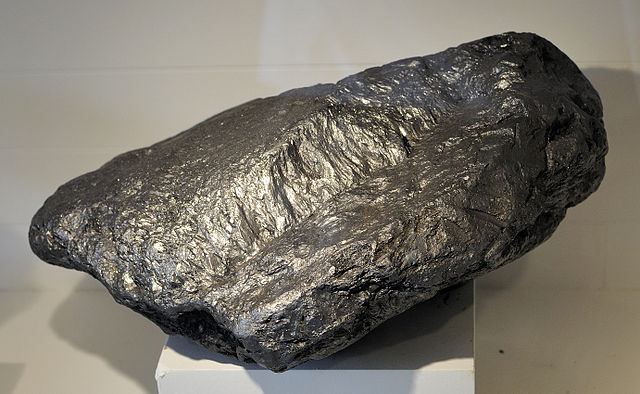
Elaborating further, he adds, “Graphite (and by extension, graphene) is a material that will see a lot of demand in future, especially since it can be used to manufacture lithium-ion batteries, which are expected to grow in demand due to the growth of the electric car industry and renewable energy industry. Between now and 2026, the global market for graphene is expected to show a Cumulative Average Growth Rate (CAGR) of 40%. Obviously, if we can ride that wave, it will be great for Sri Lanka.”
So, how does SLINTEC expect to commercialise its innovations?
Intrigued by the possibilities of nanotechnology, our minds were already wondering whether Sri Lanka would someday be the country to actually invent a Knight Rider-style molecular bonded shell that would have global car companies falling at our feet (90s kid reference, FYI). Worried about unintentionally offending the two scientists, we opt to ask them a different question instead. Specifically, that of SLINTEC’s plans to earn money.
It turns out that SLINTEC has two primary revenue streams. One is by commercialising research findings conducted along a set of pre-specified areas. Dr. De Silva terms this ‘Blue Sky Research’ or ‘Strategic Research’. How it works is that SLINTEC’s inhouse Research and Innovation team conducts research into a few pre-specified areas that have been deemed to be in alignment with SLINTEC’s mission; namely agriculture, textile and apparel, healthcare (nutraceuticals and active pharmaceutical ingredient manufacture to be specific), mineral resources, and advanced materials. Any innovations or breakthroughs that arise out of these endeavours are then patented and commercialised via licensing or an outright sale. So far, SLINTEC has managed to file for 15 patents, of which 13 are in the United States and two are in Sri Lanka.
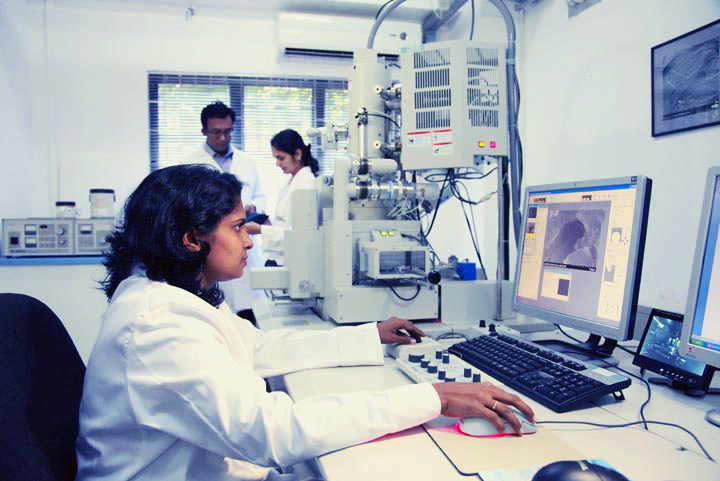
“We also managed to sell three patents to the Nagarjuna Corporation of India, which has interests in the fertiliser and chemicals sectors in India. Thanks to that sale, we generated USD 1 million in revenue,” Dr. De Silva adds triumphantly.
“The other revenue stream is contract research,” says Dr. Pahalagedara. He proceeds to explain to us how private sector organisations can engage SLINTEC to conduct research on their behalf. SLINTEC offers contract research clients three models to choose from: Exclusive IP Rights, Limited IP Rights, and Non-Exclusive IP Rights. Local apparel manufacturer Textured Jersey was one of SLINTEC’s first clients. “We helped generate over Rs. 40 million in benefits for the firm,” Dr. De Silva adds.
The Next Phase
Having come so far within a span of 10 years, SLINTEC does not want to rest on its laurels. It has already embarked on two more ambitious projects, the first being the SLINTEC Academy.
A University Grants Commission-approved institution set up under SLINTEC, the SLINTEC Academy aims to build research capacity in the country by offering postgraduate degree programmes in nanotechnology and other advanced technologies. “We are not affiliated to any foreign university,” says Prof. Veranja Karunaratne, the Vice Chancellor of the Academy, who’d just walked into the building. “But, we have our own curriculum that is on par with international standards, taught by a world-class full-time academic staff. We also offer our students a rare something: the ability to practically apply what they learn in class to create market-friendly innovations. Here at SLINTEC, we have a range of top notch equipment and all the facilities required for any researcher. So, our students can also make use of those facilities.”
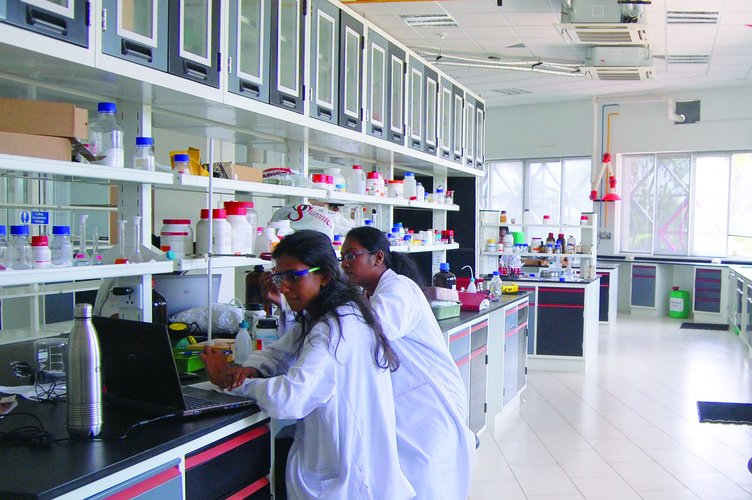
Prof. Karunaratne went on to explain to us how the Academy has a very strict enrollment criteria and that only around 10 students are admitted annually. “The way it is structured right now, we will only have a maximum of 30 students in total at any given time. This helps us to ensure that quality is maintained at a very high level.”
In order to attract deserving students, SLINTEC has also established an endowment fund, through which it expects to grant scholarships to students. “We are able to offer an academic experience that is on par with any other university in the region,” Prof. Karunaratne says proudly. “Our ability to grant scholarships is only limited by the size of our endowment, so we invite Sri Lankan expats living abroad to come forward to support the cause of science education in the country, if they can.”
The SLINTEC Startup Engine
The second great ambition SLINTEC harbours is the launch of the SLINTEC Startup Engine, which is actually an incubator-accelerator hybrid. It has been envisioned as a platform for aspiring entrepreneurs to take to market a set of pre-specified projects, as well as to attract new ideas that can be incubated within SLINTEC.
We arrive at our last stop, the office of Harin De Silva Wijeyeratne, the Chief Executive Officer of SLINTEC, who promptly walks us through the idea behind the Startup Engine programme. “One of the core tenets of SLINTEC is its entrepreneurial culture, which underpins everything we do. Therefore, we aim to not just do research, but to do research which solves a need in the market. Today, we have a portfolio of research projects with us, and we would like to provide aspiring entrepreneurs the chance to execute these projects and launch those products to the market. On the other hand, we’d also like interested individuals to come and present their ideas to us. If they fit our capabilities, we will be happy to offer them the chance to work on those ideas right here. They can make use of all our facilities and get the help of our researchers” says Mr. Wijeyeratne. “After all, it’s not practical to think that we’re the ones with all the bright ideas,” he adds with a chuckle.
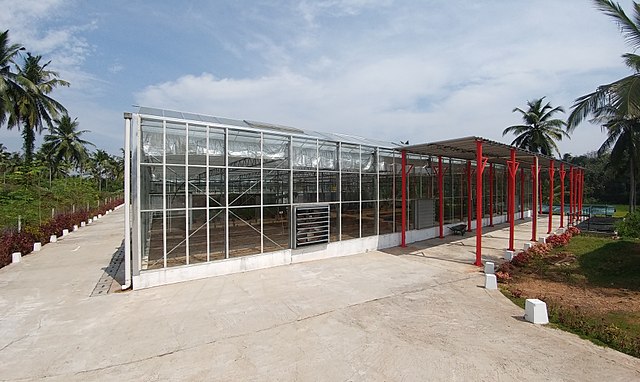
Upon further querying, Mr. Wijeyeratne explains that those applying for SLINTEC’s Startup Engine are not necessarily required to have a scientific background. “As long as you’re business savvy or have a good idea with a good enough understanding of the big picture, that’s all that we need. Other minor factors are immaterial and can be dealt with quite easily,” he says.
“We have partnered with Startup X Foundry, who will provide mentorship and help the chosen applicants with advice on areas such as product design, business structuring, market analysis, etc. We will also be helping them with raising money, manufacturing, marketing and distribution,” continues Mr. Wijeyeratne.
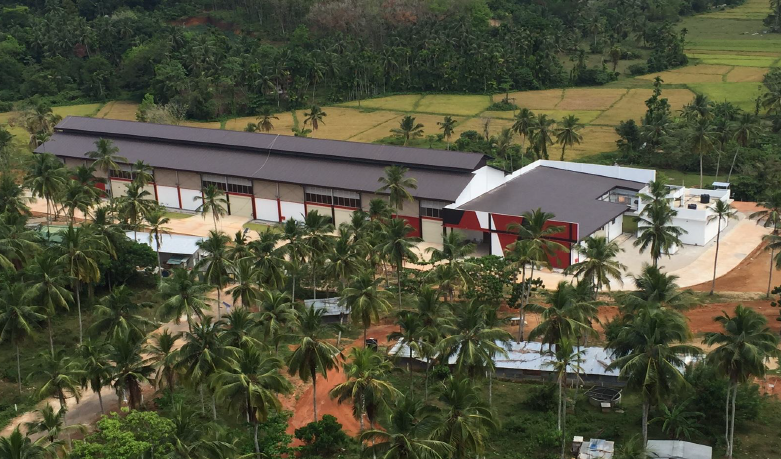
The inaugural edition of the programme is expected to launch soon, and Mr. Wijeyeratne promises that more details will be revealed in time to come. To us, the whole scheme looks very promising. In fact, it appears that SLINTEC is a fertile ground for turning ideas to reality. On the very same Nanotechnology and Science Park where SLINTEC is located is another 16,000 sq.ft. building, which is the park’s Technology Incubation Centre (TIC). Nearby is a 10,000 sq.ft. greenhouse. Both are expected to be hives of activity soon. “John Keells Research has already moved into the TIC, and they’ve already filed their first patent. We are expecting a couple of other firms including LOLC to also move in,” Mr. Wijeyeratne says. We later learn that J.L. Morison Son & Jones (Ceylon) PLC, of Morison’s Gripe Water fame and a local pharmaceutical giant in its own right, is constructing a research and manufacturing facility within the park.
The one concern expressed by Mr. Wijeyeratne was the challenge of raising the necessary operating capital to help SLINTEC achieve its mission. Though much has been done, it is clear to us that a long arduous journey lies ahead. It was also not lost on any of us that we were standing on what would perhaps one day be Sri Lanka’s, or perhaps the region’s, innovation hub. As an entirely new Tech City took shape around us, we bid goodbye to Dr. De Silva and made our way back to Colombo, with the impression that SLINTEC has the potential to help lead Sri Lanka’s transition to an innovation economy.

.jpg?w=600)
